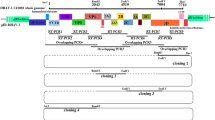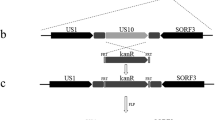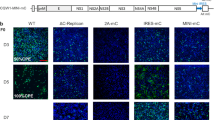Abstract
In our previous study, a recombinant duck enteritis virus (DEV) delivering codon-optimized E gene (named as E-ch) of duck Tembusu virus (DTMUV) optimized referring to chicken’s codon bias has been obtained based on the infectious bacterial artificial chromosome (BAC) clone of duck enteritis virus vaccine strain pDEV-EF1, but the expression level of E-ch in recombinant virus rDEV-E-ch-infected cells was very low. To optimize DTMUV E gene expression delivered by the vectored DEV, different forms of E gene (collectively called EG) including origin E gene (E-ori), truncated E451-ori gene, codon-optimized E-dk gene optimized referring to duck’s codon bias, as well as the truncated E451-ch and E451-dk, Etpa-ori and Etpa-451-ori, which contain prefixing chick TPA signal peptide genes, were cloned into transfer vector pEP-BGH-end, and several recombinant plasmids pEP-BGH-EG were constructed. Then the expression cassettes pCMV-EG-polyABGH amplified from pEP-BGH-EG by PCR were inserted into US7/US8 gene intergenic region of pDEV-EF1 by two-step Red/ET recombination, 7 strain recombinant mutated BAC clones pDEV-EG carrying different E genes were constructed. Next, the recombinant viruses rDEV-EG were reconstituted from chicken embryo fibroblasts (CEFs) by calcium phosphate precipitation. Western blot analysis showed that E or E451 protein is expressed in rDEV-E-ori, rDEV-E-ch, rDEV-Etpa-ori, rDEV-E451-ori, rDEV-E451-dk, and rDEV-E451-ch-infected CEFs, and protein expression level in rDEV-E451-dk-infected CEFs is the highest. These studies have laid a foundation for developing bivalent vaccine controlling DEV and DTMUV infection.





Similar content being viewed by others
References
Cao, Z., Zhang, C., Liu, Y., Liu, Y., Ye, W., Han, J., et al. (2011). Tembusu virus in ducks, china. Emerging Infectious Diseases, 7(10), 1873–1875.
Zhang, W., Chen, S., Mahalingam, S., Wang, M., & Cheng, A. (2017). An updated review of avian-origin Tembusu virus: A newly emerging avian Flavivirus. Journal of General Virology, 98(10), 2413–2420.
Liu, M., Chen, S., Chen, Y., Liu, C., Chen, S., Yin, X., et al. (2012). Adapted Tembusu-like virus in chickens and geese in China. Journal of Clinical Microbiology, 50(8), 2807–2809.
Tang, Y., Diao, Y., Yu, C., Gao, X., Ju, X., Xue, C., et al. (2013). Characterization of a Tembusu virus isolated from naturally infected house sparrows (Passer domesticus) in Northern China. Transboundary and Emerging Diseases, 60(2), 152–158.
Liu, P., Lu, H., Li, S., Moureau, G., Deng, Y. Q., Wang, Y., et al. (2012). Genomic and antigenic characterization of the newly emerging Chinese duck egg-drop syndrome flavivirus: Genomic comparison with Tembusu and Sitiawan viruses. Journal of General Virology, 93(Pt 10), 2158–2170.
Tang, Y., Diao, Y., Chen, H., Ou, Q., Liu, X., Gao, X., et al. (2015). Isolation and genetic characterization of a tembusu virus strain isolated from mosquitoes in Shandong China. Transboundary and Emerging Diseases, 62(2), 209–216.
Li, X., Shi, Y., Liu, Q., Wang, Y., Li, G., Teng, Q., et al. (2015). Airborne transmission of a novel tembusu virus in ducks. Journal of Clinical Microbiology, 53(8), 2734–2736.
Yun, T., Ye, W., Ni, Z., Zhang, D., & Zhang, C. (2012). Identification and molecular characterization of a novel flavivirus isolated from Pekin ducklings in China. Veterinary Microbiology, 157(3–4), 311–319.
King, A.M.Q., Adams, M.J., Carstens, E.B., Lefkowitz, E.J. (2012) Virus taxonomy: Classification and nomenclature of viruses: Ninth report of the International Committee on Taxonomy of Viruses (http://ictvonline.org/virusTaxonomy.asp?version=2012&bhcp=1.2012)
Wang, J., & Osterrieder, N. (2011). Generation of an infectious clone of duck enteritis virus (DEV) and of a vectored DEV expressing hemagglutinin of H5N1 avian influenza virus. Virus Research, 159(1), 23–31.
Liu, J., Chen, P., Jiang, Y., Wu, L., Zeng, X., Tian, G., et al. (2011). A duck enteritis virus-vectored bivalent live vaccine provides fast and complete protection against H5N1 avian influenza virus infection in ducks. Journal of Virology, 85(21), 10989–10998.
Liu, X., Wei, S., Liu, Y., Fu, P., Gao, M., Mu, X., et al. (2013). Recombinant duck enteritis virus expressing the HA gene from goose H5 subtype avian influenza virus. Vaccine, 31(50), 5953–5959.
Zou, Z., Liu, Z., & Jin, M. (2014). Efficient strategy to generate a vectored duck enteritis virus delivering envelope of duck Tembusu virus. Viruses, 6(6), 2428–2443.
Chen, P., Liu, J., Jiang, Y., Zhao, Y., Li, Q., Wu, L., et al. (2014). The vaccine efficacy of recombinant duck enteritis virus expressing secreted E with or without PrM proteins of duck tembusu virus. Vaccine, 32(41), 5271–5277.
Zou, Z., Hu, Y., Liu, Z., Zhong, W., Cao, H., Chen, H., et al. (2015). Efficient strategy for constructing duck enteritis virus-based live attenuated vaccine against homologous and heterologous H5N1 avian influenza virus and duck enteritis virus infection. Veterinary Research, 46, 42.
Wang, J., Ge, A., Xu, M., Wang, Z., Qiao, Y., Gu, Y., et al. (2015). Construction of a recombinant duck enteritis virus (DEV) expressing hemagglutinin of H5N1 avian influenza virus based on an infectious clone of DEV vaccine strain and evaluation of its efficacy in ducks and chickens. Virology Journal, 12, 126.
Sun, Y., Yang, C., Li, J., Li, L., Cao, M., Li, Q., et al. (2017). Construction of a recombinant duck enteritis virus vaccine expressing hemagglutinin of H9N2 avian influenza virus and evaluation of its efficacy in ducks. Archives of Virology, 162(1), 171–179.
Chang, P., Yao, Y., Tang, N., Sadeyen, J. R., Sealy, J., Clements, A., et al. (2018). The application of NHEJ-CRISPR/Cas9 and Cre-Lox system in the generation of bivalent duck enteritis virus vaccine against avian influenza virus. Viruses, 10(2), 81.
Chen, L., Yu, B., Hua, J., Ye, W., Ni, Z., Yun, T., et al. (2013). Construction of a full-length infectious bacterial artificial chromosome clone of duck enteritis virus vaccine strain. Virology Journal, 10, 328.
Chen, L., Yu, B., Ni, Z., Hua, J., Ye, W., Yun, T., et al. (2015). Construction and characterization of a recombinant duck enteritis virus expressing E protein of duck Tembusu virus. Acta Agriculturae Zhejiangensis, 27(11), 1889–1895. (in Chinese).
Yun, T., Zhang, D., Ma, X., Cao, Z., Chen, L., Ni, Z., et al. (2012). Complete genome sequence of a novel flavivirus, duck tembusu virus, isolated from ducks and geese in china. Journal of Virology, 86(6), 3406–3407.
Tischer, B. K., von Einem, J., Kaufer, B., & Osterrieder, N. (2006). Two-step red-mediated recombination for versatile high-efficiency markerless DNA manipulation in Escherichia coli. BioTechniques, 40, 191–197.
Yang, C., Li, J., Li, Q., Li, H., Xia, Y., Guo, X., et al. (2013). Complete genome sequence of an attenuated duck enteritis virus obtained by in vitro serial passage. Genome Announc, 1(5), e00685–e00685.
Lin, C. W., Liu, K. T., Huang, H. D., & Chen, W. J. (2008). Protective immunity of E. coli-synthesized NS1 rotein of Japanese encephalitis virus. Biotechnology Letters, 30(2), 205–214.
Lieberman, M. M., Clements, D. E., Ogata, S., Wang, G., Corpuz, G., Wong, T., et al. (2007). Preparation and immunogenic properties of a recombinant West Nile subunit vaccine. Vaccine, 25(3), 414–423.
Chung, K. M., Nybakken, G. E., Thompson, B. S., Engle, M. J., Marri, A., Fremont, D. H., et al. (2006). Antibodies against West Nile Virus nonstructural protein NS1 prevent lethal infection through Fc gamma receptor-dependent and -independent mechanisms. Journal of Virology, 80(3), 1340–1351.
Chung, K. M., Thompson, B. S., Fremont, D. H., & Diamond, M. S. (2007). Antibody recognition of cell surface-associated NS1 triggers Fc-gamma receptor-mediated phagocytosis and clearance of West Nile virus-infected cells. Journal of Virology, 81(17), 9551–9555.
Krishna, V. D., Rangappa, M., & Satchidanandam, V. (2009). Virus-specific cytolytic antibodies to nonstructural protein 1 of Japanese encephalitis virus effect reduction of virus output from infected cells. Journal of Virology, 83, 4766–4777.
Ishikawa, T., Wang, G., Widman, D. G., Infante, E., Winkelmann, E. R., Bourne, N., et al. (2011). Enhancing the utility of a prM/E-expressing chimeric vaccine for Japanese encephalitis by addition of the JEV NS1 gene. Vaccine, 29(43), 7444–7455.
Vazquez, S., Guzman, M. G., Guillen, G., Chinea, G., Perez, A. B., Pupo, M., et al. (2002). Immune response to synthetic peptides of dengue prM protein. Vaccine, 20, 1823–1830.
Beasley, D. W., & Barrett, A. D. (2002). Identification of neutralizing epitopes within structural domain III of the West Nile virus envelope protein. Journal of Virology, 76, 13097–13100.
Acknowledgements
The study was supported by grants from the National Key Research and Development Program of China (2016YFD0500107); the National Natural Science Foundation of China (31670150); Zhejiang Provincial Natural Science Foundation of China (Grant No. LY15C180002); and the Public Service Technology Application Research Project of Science and Technology Department of Zhejiang Province (2016C32070). We would like to thank Kui Yang, Department of Pathobiological Sciences, School of Veterinary Medicine Louisiana State University, Louisiana, USA, for critical reading of the manuscript.
Author information
Authors and Affiliations
Corresponding author
Ethics declarations
Conflict of interest
The authors declare that they have no competing interests. The founding sponsors had no role in the design of the study; in the collection, analyses, or interpretation of data; in the writing of the manuscript; and in the decision to publish the results.
Additional information
Publisher's Note
Springer Nature remains neutral with regard to jurisdictional claims in published maps and institutional affiliations.
Electronic supplementary material
Below is the link to the electronic supplementary material.
Rights and permissions
About this article
Cite this article
Chen, L., Yu, B., Hua, J. et al. Optimized Expression of Duck Tembusu Virus E Gene Delivered by a Vectored Duck Enteritis Virus In Vitro. Mol Biotechnol 61, 783–790 (2019). https://doi.org/10.1007/s12033-019-00206-1
Published:
Issue Date:
DOI: https://doi.org/10.1007/s12033-019-00206-1




